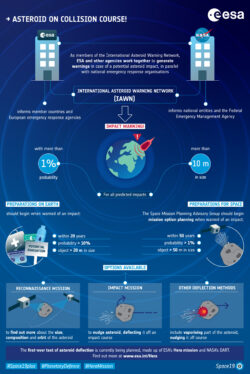5 min read
NASA Celebrates First Decade of International Asteroid Warning Network
On January 13-14, 2014, representatives from NASA and various global research organizations convened the first meeting of the International Asteroid Warning Network (IAWN) steering committee. This group was charged with strengthening coordinated international response to a potentially hazardous near-Earth object (NEO). One decade, 17 meetings, and five global exercises later, IAWN continues to build collaboration among the global planetary defense community to help identify potential threats and safeguard Earth.

A Reason for Action
In the early morning of Feb. 15, 2013, in the frosty skies above the southern Ural region in Russia, a previously undetected asteroid approximately 60 feet (18 meters) in size slammed into Earth’s atmosphere. This relatively small piece of natural space debris lit up the morning sky as it disintegrated, briefly shining brighter than the Sun as it exploded over the city of Chelyabinsk with a force equivalent to about 440 kilotons of TNT – over 20 times greater than the energy released by the first atomic bomb blast in New Mexico.
This spectacular and widely publicized event highlighted the very real but easily overlooked hazard posed by near-Earth objects (NEOs) – asteroids and comets with orbits that bring them into Earth’s vicinity – and reinforced the need for strong global coordination among the planetary-defense community.
Representatives Forge Global Collaboration
Coincidentally and fortuitously, it also occurred while the 50th session of the United Nations Committee on the Peaceful Uses of Outer Space (COPUOS) Scientific and Technical Subcommittee was convened at the International Center in Vienna.
The meteor metaphorically impacted the committee, which had already established a working group on NEOs to draft initial plans for an international response to potentially hazardous NEOs and was preparing to present its recommendations to the subcommittee. These plans, which were subsequently accepted by the UN General Assembly, called for the establishment of IAWN. In that document, IAWN was tasked with “developing a strategy using well-defined space-object detection and tracking procedures, and communication plans and protocols, to assist governments in the understanding and analysis of asteroid impact consequences for the planning of mitigation responses.”
“Chelyabinsk was the ultimate call for action during the COPUOS meeting in Vienna and it was clearly on the minds of those of us who attended the first meeting of the International Asteroid Warning Network eleven months later,” said NASA’s Planetary Defense Officer Lindley Johnson.
“Prior to this meeting, there already existed a vibrant but very informal international collaboration with NEO research,” said Kelly Fast, the Near-Earth Object Observations program manager for NASA’s Planetary Defense Coordination Office. “IAWN was the first formal effort to collaborate on an international scale for NEO observation, tracking and modeling relevant to planetary defense.”
But what did the inaugural IAWN create that we didn’t have before? In a nutshell, IAWN forged a formal worldwide collaboration of asteroid observers and modelers to detect, track, and physically characterize NEOs. This vital information about impact threats is also made accessible by any nation and government on Earth through IAWN notifications to the UN Office of Outer Space Affairs, and through the world-wide individuals and participating organizations in IAWN and their open data practices.
“In short, IAWN has been able to foster and advance the international collaboration that is critical to ensure the planetary defense community is communicating and operating using the same best practices and methods for finding, tracking, cataloging, and characterizing NEOs, and then informing the world about them,” said Johnson.
Since its inception, IAWN has led several campaigns to help check the accuracy of the observations reported by asteroid observers. It also organized practice observing campaigns of a known non-hazardous NEO to simulate what would be needed in the event an object were on a collision course with Earth.
NASA’s Role in Worldwide Network
NASA’s involvement was essential to the formation of IAWN, and its current role involves coordinating IAWN, which includes convening the semi-annual meetings of the steering committee and signatories as well as leading the periodic campaigns to exercise the astronomical and modeling capabilities of the worldwide network. IAWN currently has 55 signatories from 25 countries, representing participation by space agencies, universities, private organizations, and independent astronomers.
The Space Mission Planning Advisory Group (SMPAG) was also recommended by the UN and established with IAWN. SMPAG is the forum for the world’s space agencies to collaborate on technologies for mitigation techniques and recommend potential in-space deflection options based on information from IAWN concerning an identified impact threat. SMPAG is chaired by the European Space Agency.
“It is safe to say that IAWN and SMPAG would not exist or have been endorsed by the UN if NASA had not actively worked for their establishment and support by the UN COPUOS member states,” concludes Johnson. “This is also why NASA stepped up to initiate the coordination of IAWN activities.”
For more information about NASA’s Planetary Defense Coordination Office:
https://science.nasa.gov/planetary-defense
-end-
News Media Contact
Charles Blue
NASA Headquarters, Washington
202-802-5345
charles.e.blue@nasa.gov












